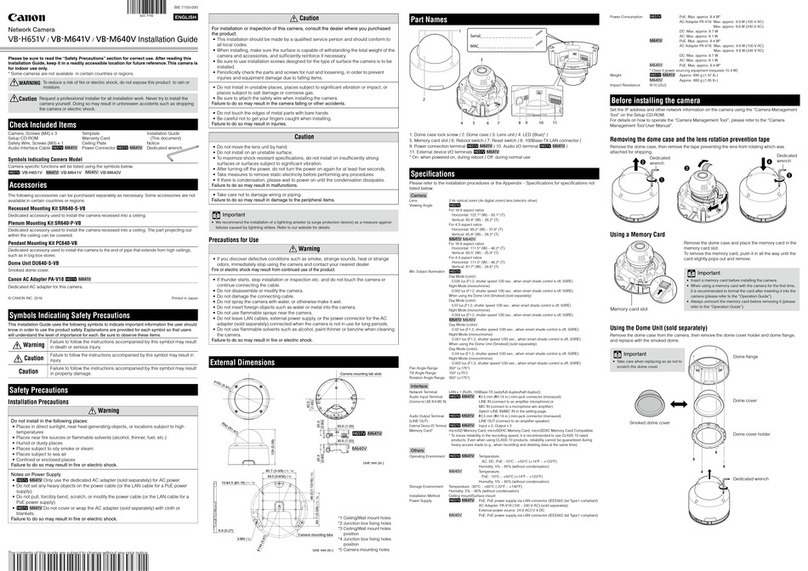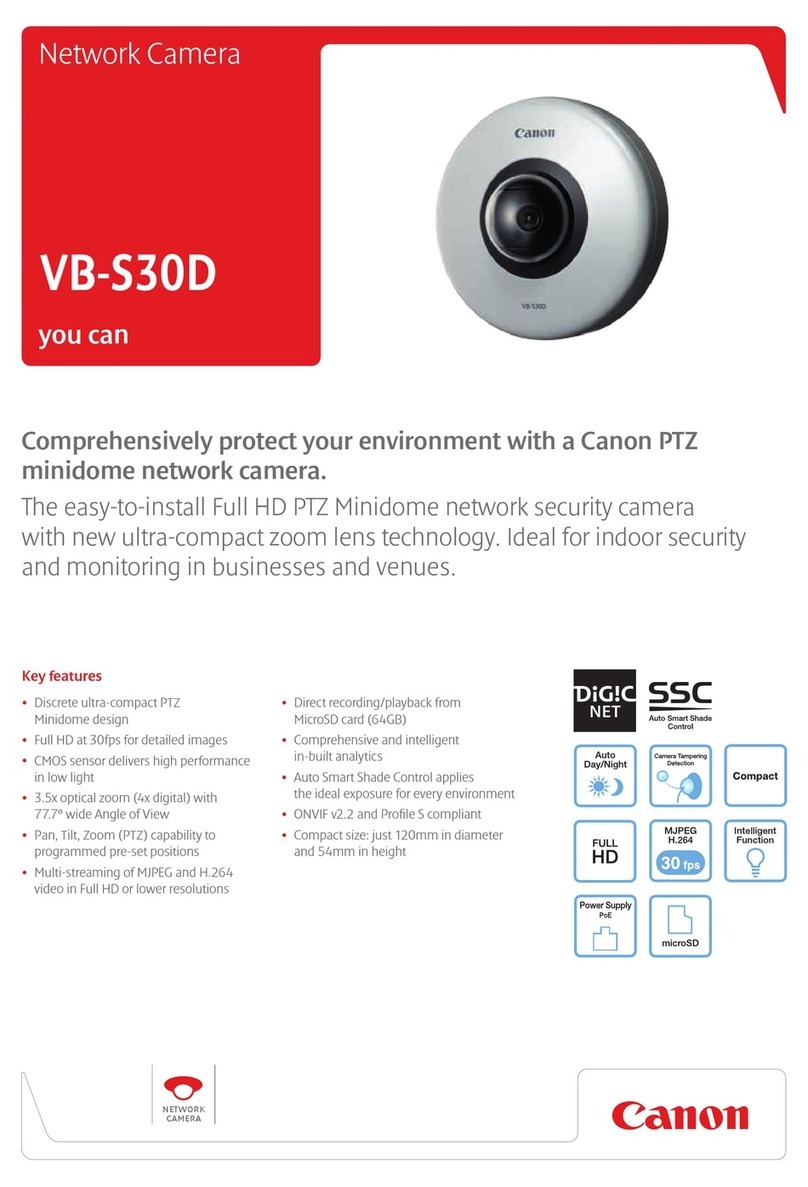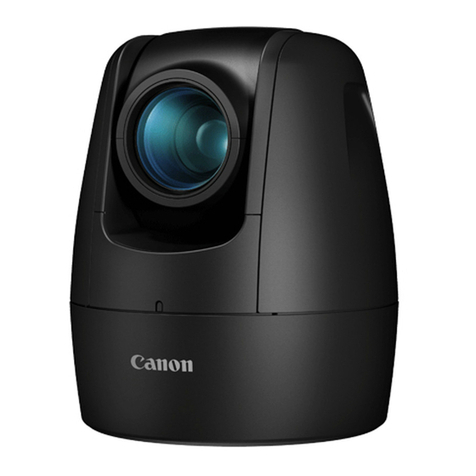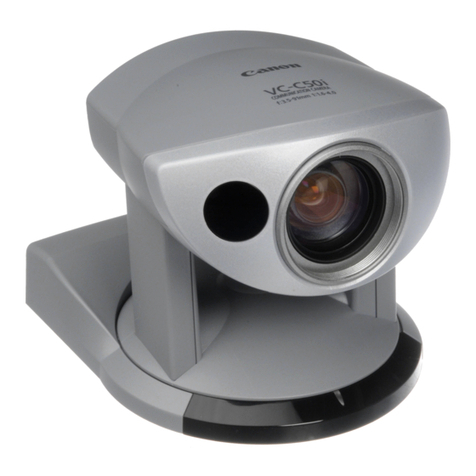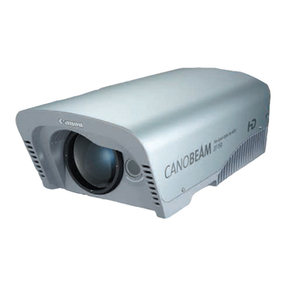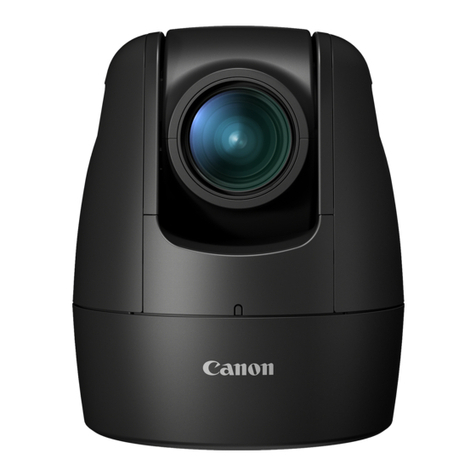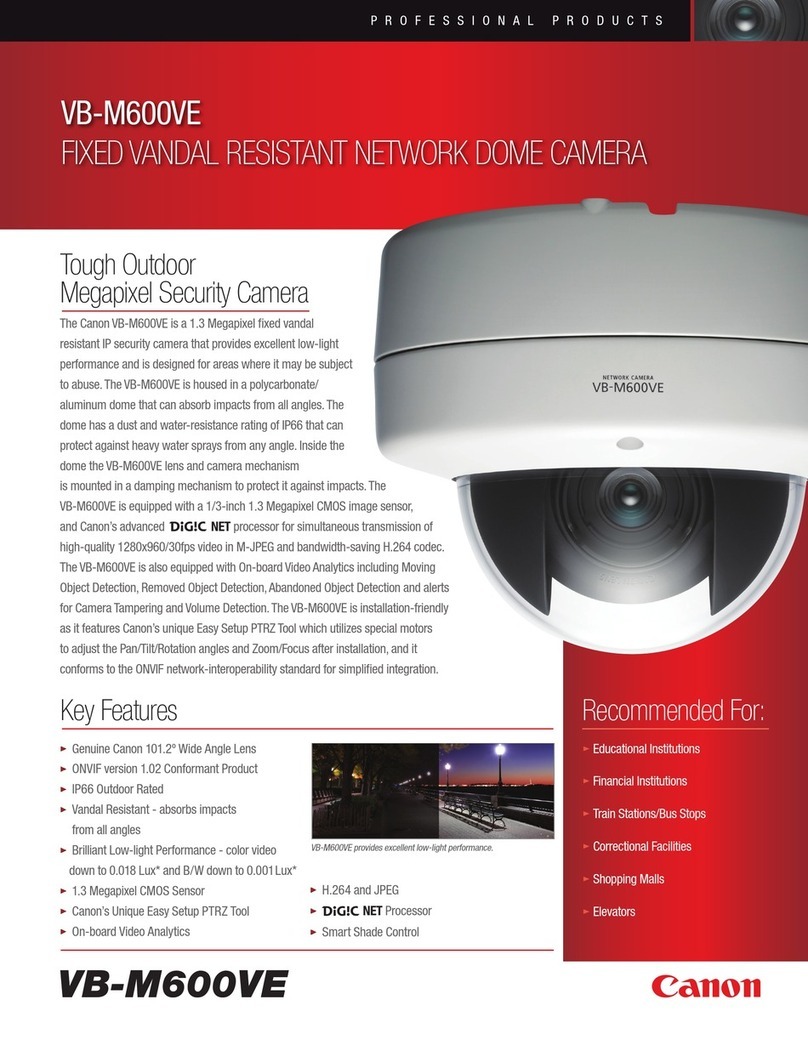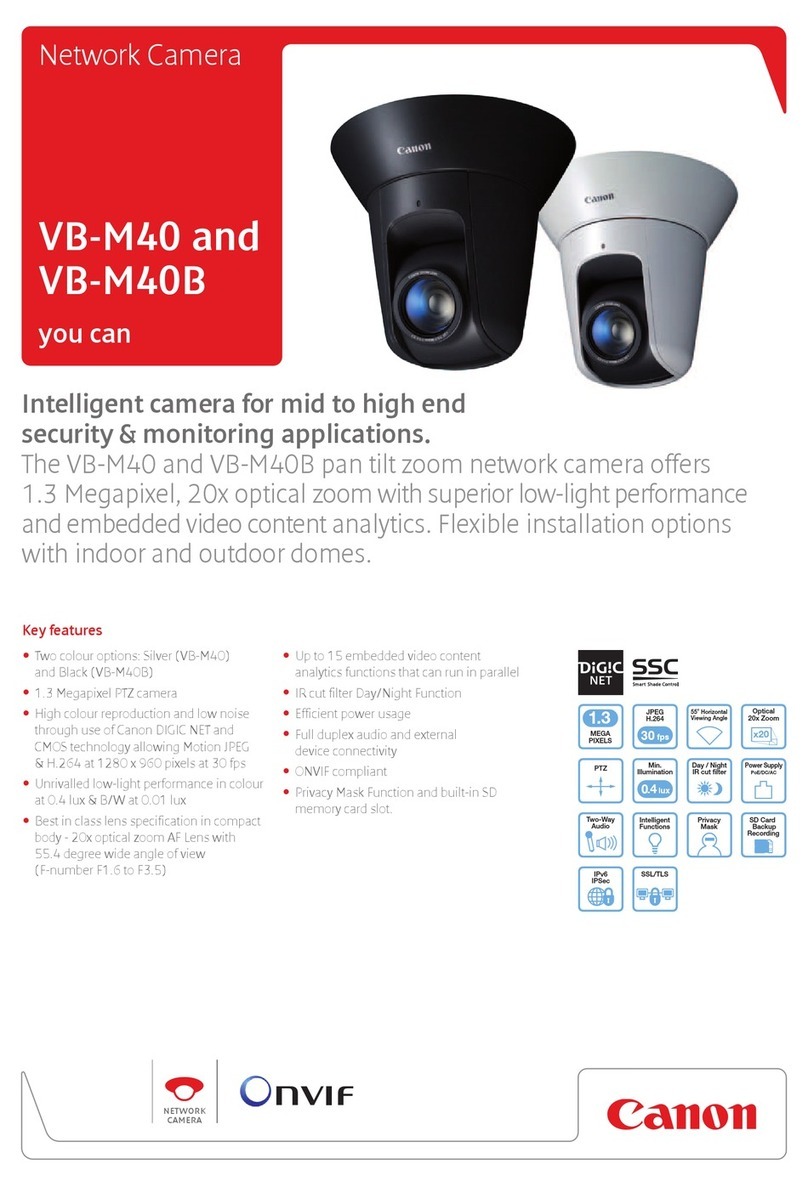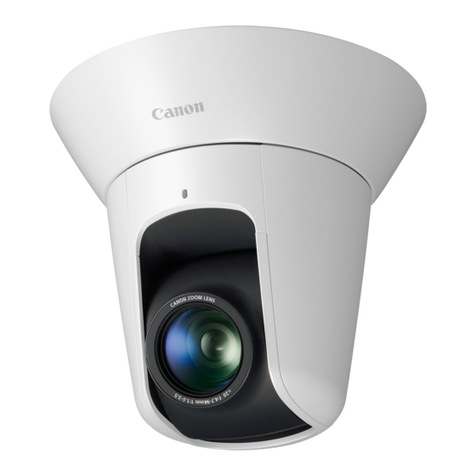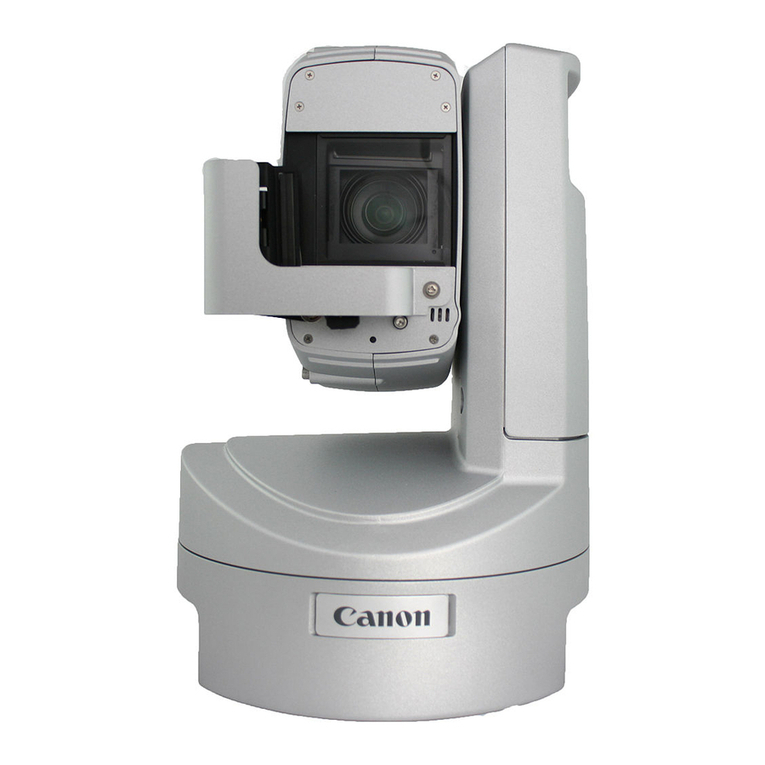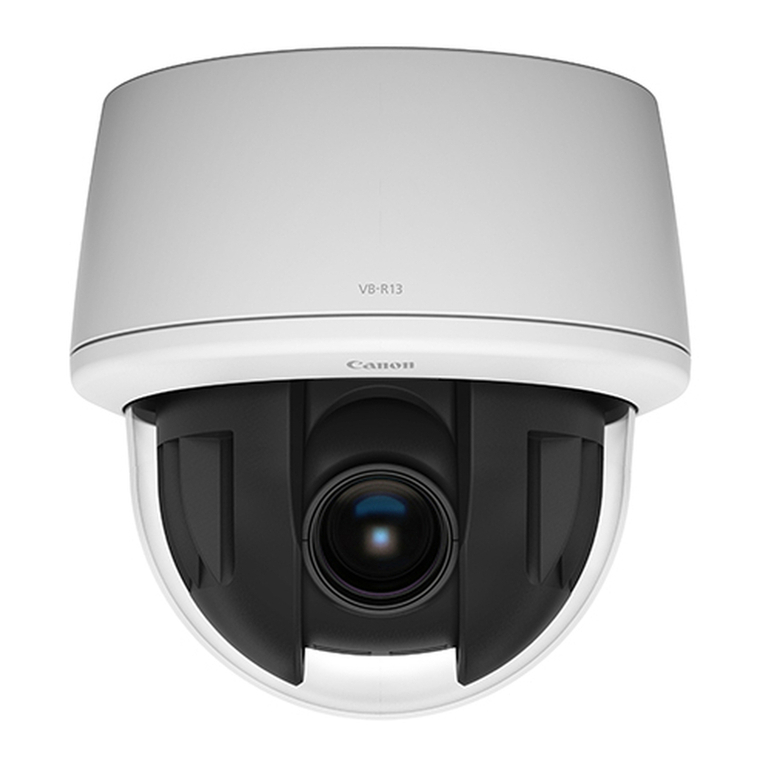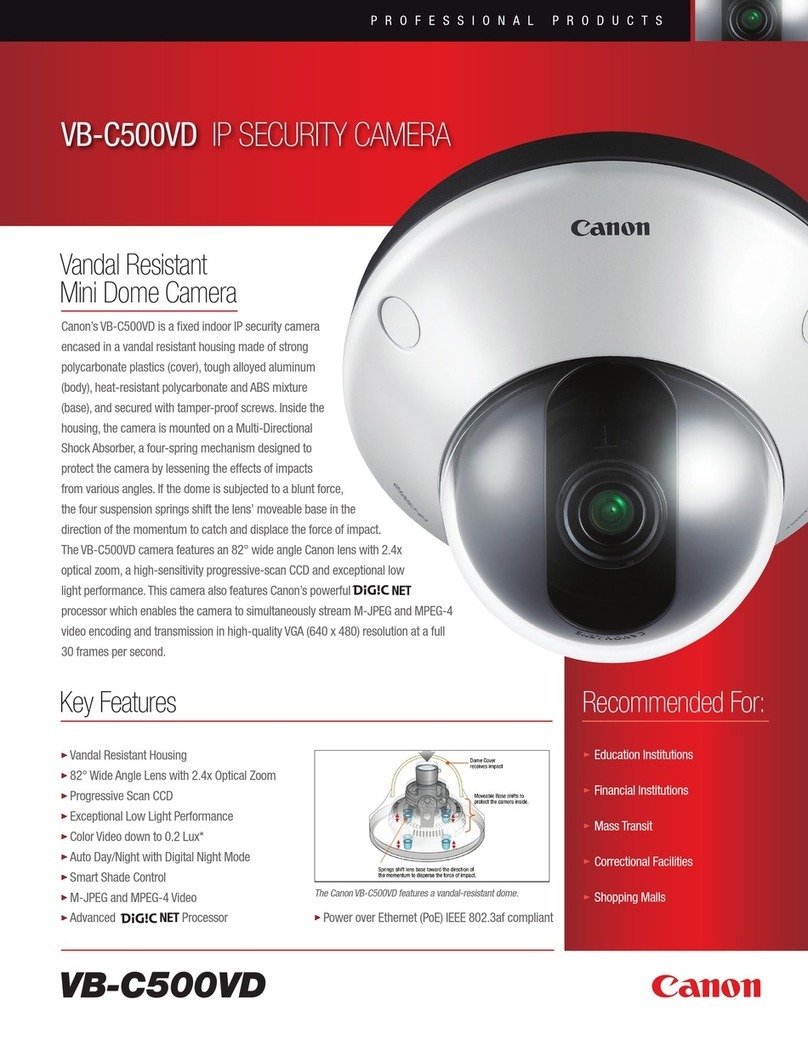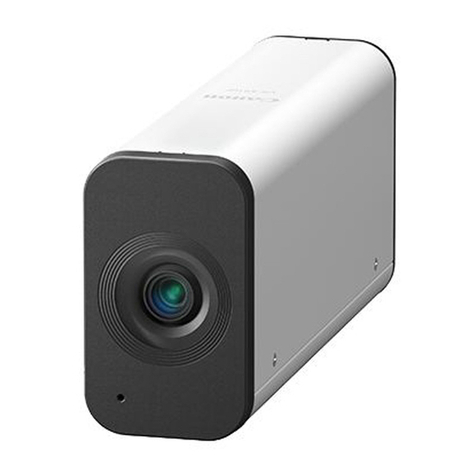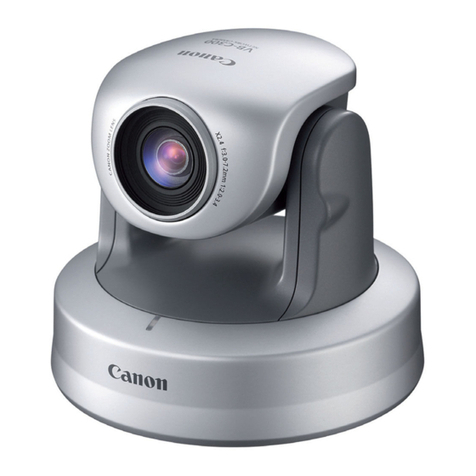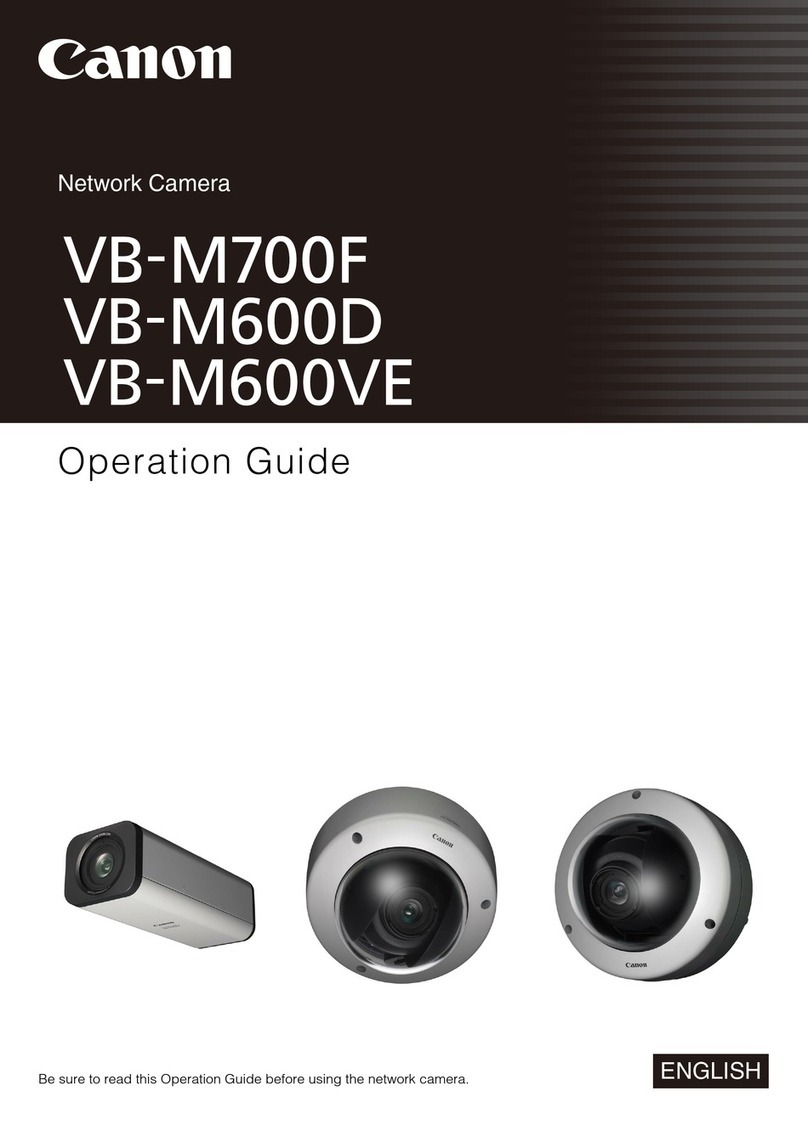
Safety Precautions
This Installation Guide uses the following symbols to indicate important information the user should
know in order to use the product safely. Be sure to observe these items.
Installation Precautions
Warning Failure to follow the instructions may result in death or serious injury.
Do not install in the following places:
• Places in strong direct sunlight, near heat-generating objects, or locations subject to
high temperatures
• Places near fire sources or flammable solvents (alcohol, thinner, fuel, etc.)
• Places subject to oily smoke or steam
• Confined or enclosed places
Failure to do so may result in fire or electric shock.
• Insulate the ends of cables you are not using.
Failure to insulate will cause fire or electric shock.
Notes on Power Supply
• Only use the dedicated AC Adapter (sold separately) for AC power.
• Do not set any heavy objects on the power cable (or the LAN cable for a PoE+/PoE
power supply).
• Do not pull, forcibly bend, scratch, or modify the power cable (or the LAN cable for a
PoE+/PoE power supply).
• Do not cover or wrap the AC adapter (sold separately) with cloth or blankets.
Failure to do so may result in fire or electric shock.
Caution Failure to follow the instructions may result in injury.
For installation or inspection of this camera, consult the dealer where you purchased
the product.
• This installation should be made by a qualified service person and should conform to
all local codes.
• When installing, make sure the surface is capable of withstanding the total weight of the
camera and accessories, and sufficiently reinforce if necessary.
• Be sure to use installation screws designed for the type of surface the camera is to be
installed.
• Periodically check the parts and screws for rust and loosening, in order to prevent
injuries and equipment damage due to falling items.
• Do not install in unstable places, places subject to significant vibration or impact, or
places subject to salt damage or corrosive gas.
• Do not install in places subject to strong winds.
• Do not install where snow can accumulate directly on the camera.
•
Be sure to attach the safety wire when installing the camera.
Failure to do so may result in the camera falling or other accidents.
• Do not touch the edges of metal parts with bare hands.
• Be careful not to get your fingers caught when installing.
Failure to do so may result in injuries.
• Avoid looking directly at the infrared illumination at close distances for long
periods of time.
Intense infrared illumination can cause eye damage.
Caution Failure to follow the instructions may result in property damage.
• Do not install on an unstable surface.
• After turning off the power, do not turn the power on again for at least five seconds.
• Take measures to remove static electricity before performing any procedures.
• If there is condensation, please wait to power on, until the condensation dissipates.
• Please waterproof and dust-proof camera, when installing outdoors.
Failure to do so may result in malfunctions.
• Take care not to damage wiring or piping.
Failure to do so may result in damage to peripheral items.
Important
• We recommend the installation of a lightning arrester (a surge protection device) as a measure against
failures caused by lightning strikes. Please refer to our website for details.
Precautions for Installing the Camera Outdoor
When installing the camera outdoors, observe the following
precautions to retain waterproof/dustproof capabilities.
• Completely wrap the cable connections and the ends of cables
you are not using, including the connectors, with waterproof tape
up to the cable jacket, so as not to allow water to enter. Please
refer to the waterproofing explanation sheet for details on how to
wrap the waterproofing tape.
• When mounting the camera onto a wall or other upright surface,
make sure that the cables are facing down to prevent rain
infiltration.
• If wiring by connecting the camera to the composite pipe, bridge
the gap using the conduit box (sold separately). When connecting
the conduit box and the pipe, apply silicon sealant to seal it tightly
after attaching the pipe to prevent water getting in as necessary.
Precautions for Use
Warning Failure to follow the instructions may result in death or serious injury.
• If you discover defective conditions such as smoke, strange sounds, heat or strange
odors, immediately stop using the camera and contact your nearest dealer.
Fire or electric shock may result from continued use of the product.
When there is condensation on the lens protector after being turned on
Condensation can occur on the inside of the lens protector, when the power has been turned on
for the first time after installation, or after not being turned on for a long time. The condensation will
dissipate after the power has been left on a while (this may take more than a day at the longest),
please wait to use the camera until you can confirm that the image is correctly visible.
Rebooting/Resetting the Camera
Rebooting
To reboot the camera by turning its power off and on,
open the memory card cover and press the reboot switch.
Note
Rebooting can be done from the camera settings page as
well (please refer to the “Operation Guide”).
Resetting
To reset the camera to its factory default settings, press the reset switch and the reboot switch
while checking the LED in the following order.
1) Hold the reset switch down, and press the reboot switch with a pointed object.
2) After holding down the reset switch for at least three seconds, release the reboot switch.
3) After the LED starts to blink, release the reset switch.
When the blinking has stopped, the unit has finished resetting.
Once this has been completed, close the memory card cover and tighten the screws with the
dedicated wrench.
Connecting the Camera
To prevent cable connections from shorting out, wrap each individual connection with insulating
tape, and then wrap all of the cables with waterproofing tape.
Power Connection
Power can be supplied to the camera in the three ways described below. Please be sure to read
the user manual for the dedicated power supply before use.
Note
• Power supply should conform to all local codes.
• The power supply should also comply with IEC/UL60950-1 (SELV/LPS) standards.
PoE+ /PoE (Power over Ethernet)
Power can be supplied to the camera by using a LAN cable connected to a PoE HUB that
conforms to the IEEE802.3at Type 2 (PoE+)/Type 1 (PoE) standard.
Important
• Check with your dealer for more information about PoE+/PoE HUB and Midspan technology.
Midspan (a LAN cable power supply device) is a device that, like a PoE+/PoE HUB, supplies power to
the camera via a LAN cable.
• Some PoE+/PoE HUBs allow the limitation of power for each port, but applying limits may interfere with
performance. If using this type of PoE+/PoE HUB, do not limit the operating power.
• Some PoE+/PoE HUBs have limits for the total power consumption for the ports, which can interfere with
performance when multiple ports are in use. For more information, check the instruction guide for your
PoE+/PoE HUB.
• When the camera is connected to both a PoE+/PoE HUB and an external power supply (12 V
DC or 24 V AC), power will be supplied in the following order of precedence.
External power supply (24 V AC) > PoE+/PoE HUB > External power supply (12 V DC)
However, when connecting power from both, certain combinations could cause problems such as
unstable network connections. If a problem arises, disable one of the power supplies.
External Power Supply
12 V DC or 24 V AC input can be used. Use the included interface cable to connect to the camera
power connection terminal.
1
3
1: BROWN Power 24 V AC / 12 V DC non-polar
2: BLUE Power 24 V AC / 12 V DC non-polar
3: GREEN FG (frame ground)
12 V DC can be connected in a non-polar configuration.
Important
• The power supply should be within the following voltage range.
• 24 V AC: Voltage fluctuation within ±10% of 24 V AC (50 Hz or 60 Hz ±0.5 Hz or less)
Current supply capacity of at least 1.0 A per camera
• 12 V DC:
Voltage fluctuation within ±10% of 12 V DC
Current supply capacity of at least 1.5 A per camera
• When using a 12 V DC battery power supply, be sure to connect resistors of at least 0.5 – 1.0 Ω/20 W in
series to the power line.
• For an external power supply, use a double-insulated device.
Recommended Power Cables [Reference]
Cable (AWG) 24 22 20 18 16
12 V DC maximum cable length m
(ft.)
5
(16.4)
9
(29.5)
14
(45.9)
23
(75.5)
32
(105.0)
24 V AC maximum cable length m
(ft.)
11
(36.1)
18
(59.1)
29
(95.1)
46
(150.9)
64
(210.0)
Please use UL cable (UL-1015 or equivalent) for 12 V DC or 24 V AC wiring.
LED
Reset switch
Reboot switch
• If thunder starts, stop installation or inspection etc. and do not touch the camera or
continue connecting the cable.
• Do not disassemble or modify the camera.
• Do not damage the connecting cable.
• Do not insert foreign objects such as water or metal into the camera.
• Do not use flammable sprays near the camera.
• Do not leave LAN cables, external power supply, or the power connector for the AC
adapter (sold separately) connected when the camera is not in use for long periods.
• Do not use flammable solvents such as alcohol, paint thinner or benzine when cleaning
the camera.
Failure to do so may result in fire or electric shock.
Specifications
Please refer to the installation procedures or the Appendix – Specifications for specifications not
listed below.
Lens 2.4x optical zoom (4x digital zoom) lens (electric drive)
Viewing Angle For 16:9 aspect ratios
Horizontal: 113.4° (W) – 46.5° (T)
Vertical: 61.4° (W) – 26.2° (T)
For 4:3 aspect ratios
Horizontal: 113.4° (W) – 46.5° (T)
Vertical: 83.0° (W) – 34.9° (T)
Pan Angle Range 344° (±172°)
Tilt Angle Range 93° (-3° – +90°) Camera is at 0° when attached to the ceiling and facing straight down, and
90° when at a horizontal position.
Rotation Angle Range 344° (±172°)
Network Terminal*
LAN x 1 (RJ45, 100Base-TX (auto/full-duplex/half-duplex))
* Use a category 5 or better LAN cable, 100 m (328 ft.) or less in length.
Audio Input Terminal 3.5 mm ( 0.14 in.) mini-jack connector (monaural)
(Common LINE IN & MIC IN)
Audio Output Terminal
3.5 mm ( 0.14 in.) mini-jack connector (monaural)
(LINE OUT)
External Device I/O Terminal
Input x 2, Output x 2
Memory Card SD Memory Card, SDHC Memory Card, SDXC Memory Card Compatible.
Operating Environment
Temperature:
Operating Temperature Range (including direct sun exposure)
AC, PoE+: -50°C – +55°C (-58°F – +131°F)
DC, PoE: -10°C – +55°C (+14°F – +131°F)
Start-up Temperature Range (including direct sun exposure)
AC, PoE+: -30°C – +55°C (-22°F – +131°F)
DC, PoE: -10°C – +55°C (+14°F – +131°F)
Humidity: 5% – 85% (without condensation)
Temperature:
Operating Temperature Range (including direct sun exposure)
PoE: -10°C – +55°C (+14°F – +131°F)
Humidity: 5% – 85% (without condensation)
Storage Environment Temperature: -30°C – +60°C (-22°F – +140°F)
Humidity: 5% – 90% (without condensation)
Installation Method Ceiling mount/Surface mount
Power Supply
PoE: PoE power supply via LAN connector
(IEEE802.3at Type1/Type2 compliant)
AC Adapter: PA-V18 (100 – 240 V AC) (sold separately)
External power source: 24 V AC/12 V DC
PoE: PoE power supply via LAN connector
(IEEE802.3at Type1 compliant)
IR Illumination Range (T)
30 m (98.4 ft.) (When using 24 V AC, PoE+)
20 m (65.6 ft.) (When using 12 V DC, PoE)
Power Consumption PoE+: Max. approx. 21.2 W*1
PoE: Max. approx. 10.1 W*2
AC Adapter PA-V18: Max. approx. 12.8 W (100 V AC)
Max. approx. 12.8 W (240 V AC)
DC: Max. approx. 11.1 W
AC: Max. approx. 22.2 W
*1Class 4 power sourcing equipment (requests 30.0 W)
*2Class 0 power sourcing equipment (requests 15.4 W)
PoE: Max. approx. 7.4 W*
* Class 0 power sourcing equipment (requests 15.4 W)
Weight Approx. 2120 g (4.68 lb.)
Approx. 2040 g (4.50 lb.)
Dust-resistant/
Waterproof Specification
IP66
AC Adapter
Please use the dedicated AC Adapter (sold separately).
Remove the power connector attached to the AC adapter, then connect the power interface cable
from the power connector included in the package, as shown in the following diagram.
AC Adapter
Power Interface
Cable
Black
Brown
Blue
Green White
Insulate
External Device I/O Terminals
External device I/O terminals consist of two input and output systems each. The Viewer can be
used to check external device input status and control output to an external device (please refer
to the “Operation Guide”).
Use the included I/O interface cable to connect to external device input/output terminals.
1: BROWN External device input 1 IN1 (+)
2: BLACK External device input 1 IN1 (-)
3: RED External device input 2 IN2 (+)
4: BLACK External device input 2 IN2 (-)
5: ORANGE External device output 1 OUT1
6: YELLOW External device output 1 OUT1
7: GREEN External device output 2 OUT2
8: BLUE External device output 2 OUT2
1
8
External Device Input Terminals (IN1, IN2)
External device input terminals consist of two sets (IN1, IN2) of two terminals, with the negative
terminals connected to the camera interior GND. Connecting cables to the positive and negative
terminals and opening or closing the circuit notifies the Viewer.
Important
• When connecting sensors and switches, connect terminals that are electrically isolated from the
respective power and GND.
External Device Output Terminals (OUT1, OUT2)
External device output terminals consist of two sets (OUT1, OUT2) of two terminals. The sets
have no polarity. Controls from the Viewer can be used to open and close the circuit between
the terminals. Using optical couplers, the output terminals are isolated from the camera’s internal
circuit.
The load connected to the output terminals should be within the following rating range.
Rating between output terminals:
Maximum voltage 50 V DC
Continuous load current at or below 100 mA
On resistance: Max. 30 Ω
Audio Input/Output Terminals
Each audio input/output terminal has one input system and one output system.
Connecting the camera to an audio input/output device such as a microphone or a speaker with
an amplifier allows you to send/receive audio through the Viewer.
Use the 3.5 mm ( 0.14 in.) monaural mini-jack connector to connect an audio input/output
device.
Audio Input Terminal Common LINE IN/MIC IN (monaural input)
Although the camera only has a single audio input system, it supports two types of microphone
input: LINE IN and MIC IN. Before using the audio input, please confirm the [Audio Input] on the
Setting Page (please refer to the “Operation Guide”). LINE IN is selected by default.
Input terminal: 3.5 mm ( 0.14 in.) mini jack (monaural)
• Dynamic MIC IN
Input impedance: 1.5 kΩ±5%
* Supported microphones: Output impedance: 400 – 600 Ω
• Condenser MIC IN
Input impedance (microphone bias resistance): 2.2 kΩ±5%
Microphone power supply: plug-in power (voltage: 2.3 V)
* Supported microphones: Condenser microphones with plug-in power support
• LINE IN
Input level: Max. 1 Vp-p
* Please use a microphone with an amplifier.
Audio Output Terminal LINE OUT (monaural output)
Connect the camera to a speaker with an amplifier. Audio can be sent to the speaker from Viewer.
Output terminal: 3.5 mm ( 0.14 in.) mini jack (monaural)
Output level: Max. 1 Vp-p
* Please use a speaker with an amplifier.
Internal Connection Diagram
Internal controller
External device Input terminal
IN1, IN2
Output terminal
OUT1, OUT2
+3.3 V
0.1 µF
10 kΩ10 kΩ1 kΩ
External device
Only for European Union and EEA (Norway, Iceland and Liechtenstein)
These symbols indicate that this product is not to be disposed of with your household waste,
according to the WEEE Directive (2012/19/EU), the Battery Directive
(2006/66/EC) and/or national legislation implementing those Directives.
If a chemical symbol is printed beneath the symbol shown above, in
accordance with the Battery Directive, this indicates that a heavy metal
(Hg = Mercury, Cd = Cadmium, Pb = Lead) is present in this battery or
accumulator at a concentration above an applicable threshold specified in
the Battery Directive.
This product should be handed over to a designated collection point, e.g., on an authorized
one-for-one basis when you buy a new similar product or to an authorized collection site for
recycling waste electrical and electronic equipment (EEE) and batteries and accumulators.
Improper handling of this type of waste could have a possible impact on the environment and
human health due to potentially hazardous substances that are generally associated with EEE.
Your cooperation in the correct disposal of this product will contribute to the effective usage of
natural resources.
For more information about the recycling of this product, please contact your local city office,
waste authority, approved scheme or your household waste disposal service or visit www.
canon-europe.com/weee, or www.canon-europe.com/battery.
CANON INC.
30-2, Shimomaruko 3-chome, Ohta-ku, Tokyo 146-8501, Japan
CANON EUROPA N.V.
Bovenkerkerweg 59, 1185 XB Amstelveen, The Netherlands
